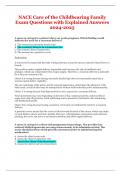Exam (elaborations)
NACE Care of the Childbearing Family Exam Questions with Explained Answers
- Course
- Institution
NACE Care of the Childbearing Family Exam Questions with Explained Answers A nurse is caring for a patient who is 40 weeks pregnant. Which finding would indicate the need for a cesarean delivery?
[Show more]



